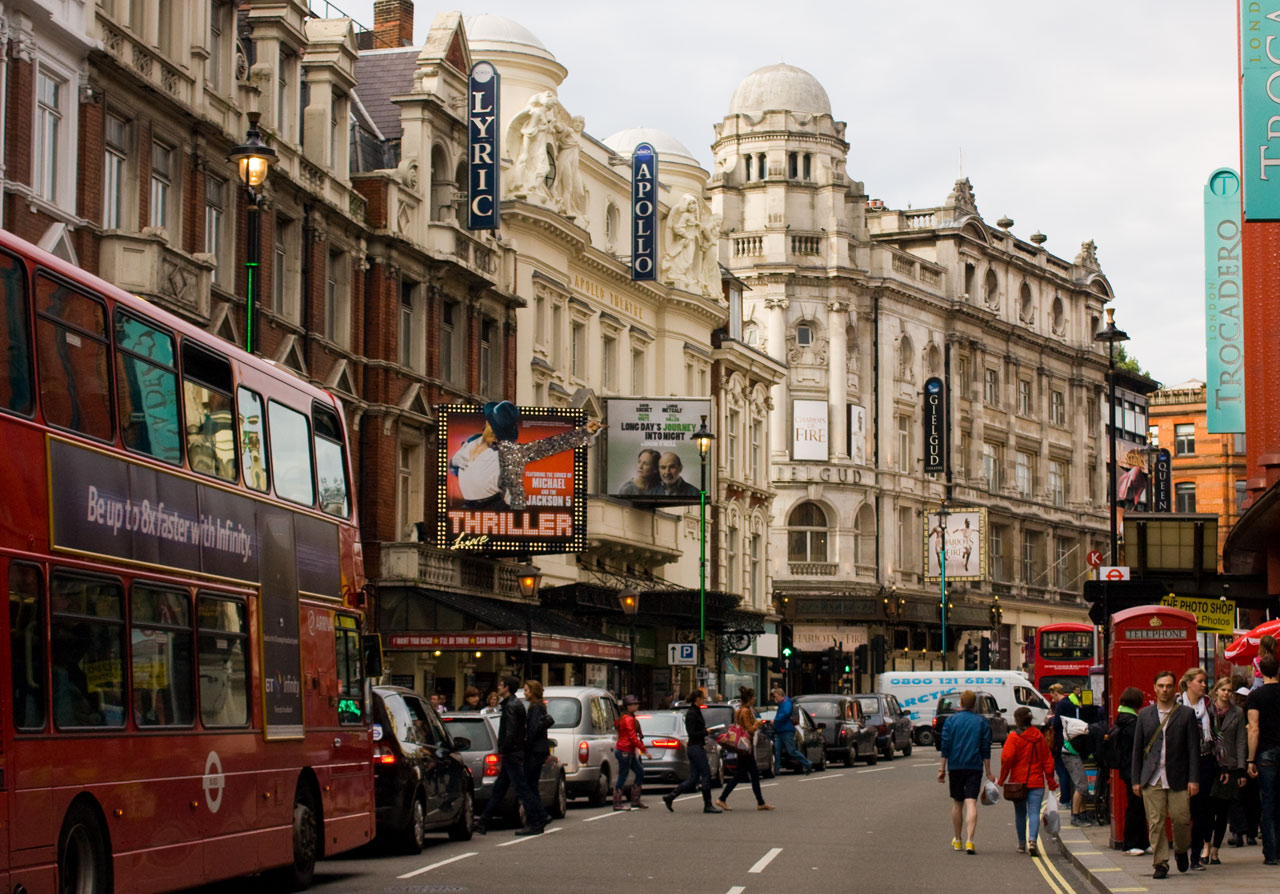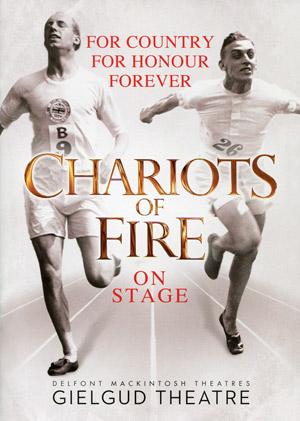In 2012, the year of the Olympic games in London, a stage play version of "Chariots of Fire" was produced, with the participation of producer Hugh Hudson, director of the 1981 movie, and of course with adapted as well as new original music by Vangelis, composer of the Oscar winning score for the film.
Chariots of Fire on Stage, London (2012)
Rhythm

Nothing sends more shivers down the spine than the promise of a nostalgic bit of music, while its delivery is suspended. The effect is instant: When the "Chariots of Fire" stage play commences, the music starts with barely more than the haunting sound of the rhythmic percussion of the famous main theme. The runners run, the tension builds. You hear the melodies in your imagination but it's not actually there. Until finally the throbbing synthesizer sound enters the stage, the CS80 horn kicks in and you are finally treated the suspended delivery of Britain's most iconic piece of sports music.
It's now 30 years since the movie ruled the box office and "stole" all those Oscars from the Americans, while Vangelis' main theme hit the charts and topped it for weeks in countries on both sides of the ocean. It may seem unlikely at first, but the idea to adapt such a movie for the stage, apparently initiated by a bet between movie director Hugh Hudson and producer Barbara Broccoli (yes, of James Bond fame and daughter of Albert R. Broccoli!) was no doubt propelled into production by the power of the Olympic games being hosted by the city of London. It made its way to the stage at the Hampstead theater and climbed the ladder all the way to London's prestigious West End district, winning the hearts of both critics and the public. It went on to sell out almost all of its performances, and pleasantly surprised even the most skeptical of critics. One might say the play is now driving the Olympic hype as much as the Olympics were driving the play.

Somehow, every piece of the puzzle fell into place, including the key task of convincing Vangelis to return to the material and augment his original movie score with new and re-imagined material for the stage play. It took only a few performances of its original run at the Hampstead Theatre before "West End" picked up on the vibe and adapted the play for performances at the Gielgud theater, where it is being performed ever since and will continue to run at least until November 10, with daily performances (except on Sunday) and extra matinee editions on Wednesday and Saturday.
Each night, as the audience enters the modified theater, the actors are already active on stage, stretching and warming up, as if you enter a sports stadium, ready to enjoy the Athletics competition at an Olympic event. The theater has been altered. Tracks have been placed between rows of seats, so that the running can take place among the audience, or all around you, depending on your seat, while there are even a few more rows to seat an audience on the opposite side of the stage. It takes some effort to get the audience into place, but at least you know you'll get to see something out of the ordinary, when the lights go dim.
And that's when the rhythm starts...

The Play

The running segment that opens the play in style is quickly followed by the story we know so well from Hugh Hudson's movie. The adaptation is quite faithful and even though condensed at points, it is also expanded in other parts. The biggest difference from the movie is probably the tone of the performances. Where the film's restrained mood always has a serious undertone, even when its dryly funny, the play has a more frivolous mindset and is more outspokenly acted, as befits the stage. The humor is louder, the tempo is faster, and the running more energetic. At points the physical performances turn into dance acts, and there are parts where the Gilbert and Sullivan songs heard in the movie are performed in ensemble by the cast. But it never takes over the story, and makes up for where cinematic excellence is left behind.
It's a true pleasure to see how some of the movie's untranslatable features are compensated. There is no slow-motion in the world of theater performances, at least not without unwelcome laughter, but the use of a revolving stage in addition to the race tracks crossing the audience does evoke a similar sense of sustained time and communicates the same energy and sportive spirit. As do a series of other tricks cleverly recreate the emotive feeling of a photo finish or the careful cinematic analysis of a key competitor' running techniques.
The cast is great, combining the right faces with appropriate charisma. The sets are perfect, at the same time minimalist and spectacular. The direction is fast (perhaps too fast) and balanced. Anything you'd want from an interesting night out at the theater.
And then there is...
The music

The main focus of the music used in the production is on the famous Vangelis tune, used in its original form and as a slightly updated version. It returns more than once.
Eric's theme and Abraham's theme are also featured. Several new themes are introduced, but as you might expect from the stage, they only appear briefly, to quickly set the mood for a scene, or to accompany a quick action sequence. The main focus on stage is on the dialog, and an abundance of music could easily muddle the narrative. However short the music bursts, they sound fantastic, and serve great to wet the appetite for the soundtrack album for the play.

Whoever made the decisions knew exactly when to use the original recordings, and when to reach for Vangelis' new deliveries. Vangelis had the courage to bring new themes and sounds into the mix, avoiding the obvious risk of producing an unintentional self parody, and updating the story's musical emotions while recognizing the necessity to retain some of the qualities of the original telling of this story.
While space for music during the play was limited, the audience can spend more time to enjoy two pieces of music played outside the scope of the play: Newly performed Vangelis music played over the speakers at the theater, both during intermission time and right after the show, while the audience leaves its seats. Again, all of this music seems to have been included on the new release, as "Aspiration" and "After the Race" respectively, if memory serves me right.
Judging quickly, comparing memory to the album, it would seem that all the music used in the play is represented on the CD, with differences only in the editing. The release faithfully covers anything you might be looking for after seeing the play. That and more, to match expectations for a Vangelis release.


The theater
The play is currently staged at the Gielgud Theatre, the former Hicks Theatre and former Globe Theater, named after John Gielgud since 1994, the actor who in fact played a small role in the movie. The Gielgud Theatre is housed in a wonderful classical style building at the heart of the West End district, just a stone's throw away from Piccadilly Circus. This is indeed a very crowded district, bristling with night life by the time an evening's performance ends, which adds an extra layer to the experience.
You enjoy the production, enjoy the music, but on top of that, you're part of the audience. You experience the buzz of energy picked up by the people attending and you can feel how proud the British are of this story and the "Chariots of Fire" concept. And you can hear it! As we did, when the audience ascended the stairs and fetched their coats. The theme music was everywhere, in the shape of thoughtless humming and pasionate whistling. Energy that lasted long after the audience blended in with the crowd in the streets.
Collectors

Collectors may enjoy some of the goodies that are on sale at the theater. An official program lists details of the production and the play, which was the source of each of the photographs on this page. Vangelis has a small chapter in the booklet, but only the actors are listed with photographs.
The "Chariots of Fire" logo has been printed on various goods as official merchandise, including a coffee mug, T-shirts, a kit bag and a medallion. And finally, the theater should also be selling the soundtrack CD, since after its release.
All these are for sale at a special counter in the lobby, which opens some time before each performance.

First run: The Hampstead Theatre (London) May 9 until June 16 (completed) Second run: The Gielgud Theatre (London) Shaftesbury Avenue, London, W1D 6AR (The West End district, near Piccadilly Circus) Box Office phone: 0844 482 5138 June 22 to November 10 Monday 7:45pm Tuesday 7:45pm Wednesday 3pm, 7:45pm Thursday 7:45pm Friday 7:45pm Saturday: 3pm, 7:45pm

